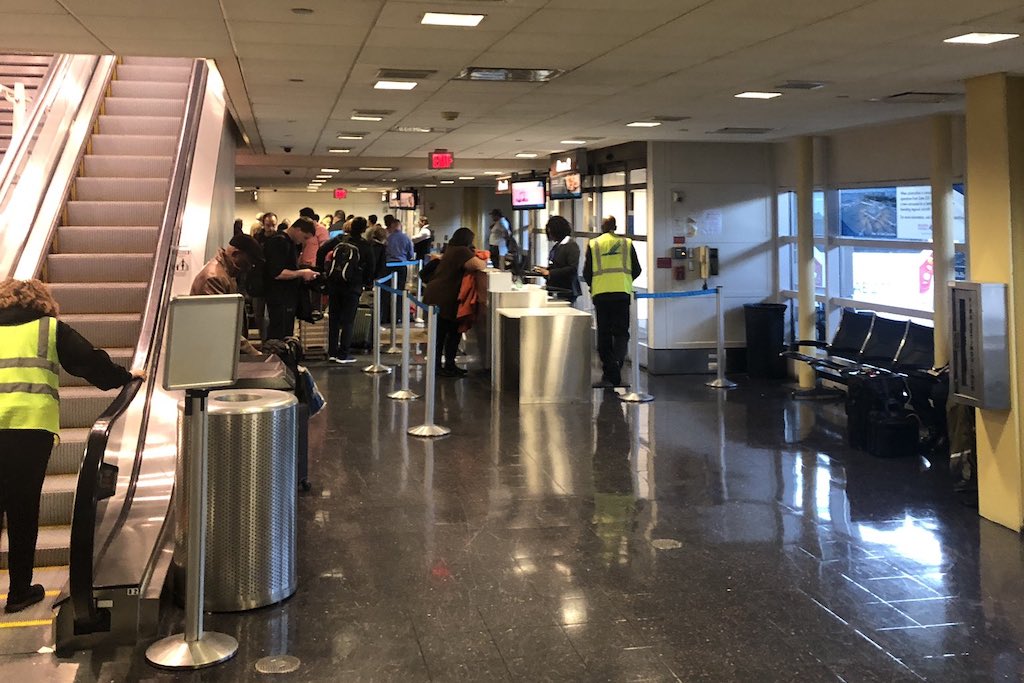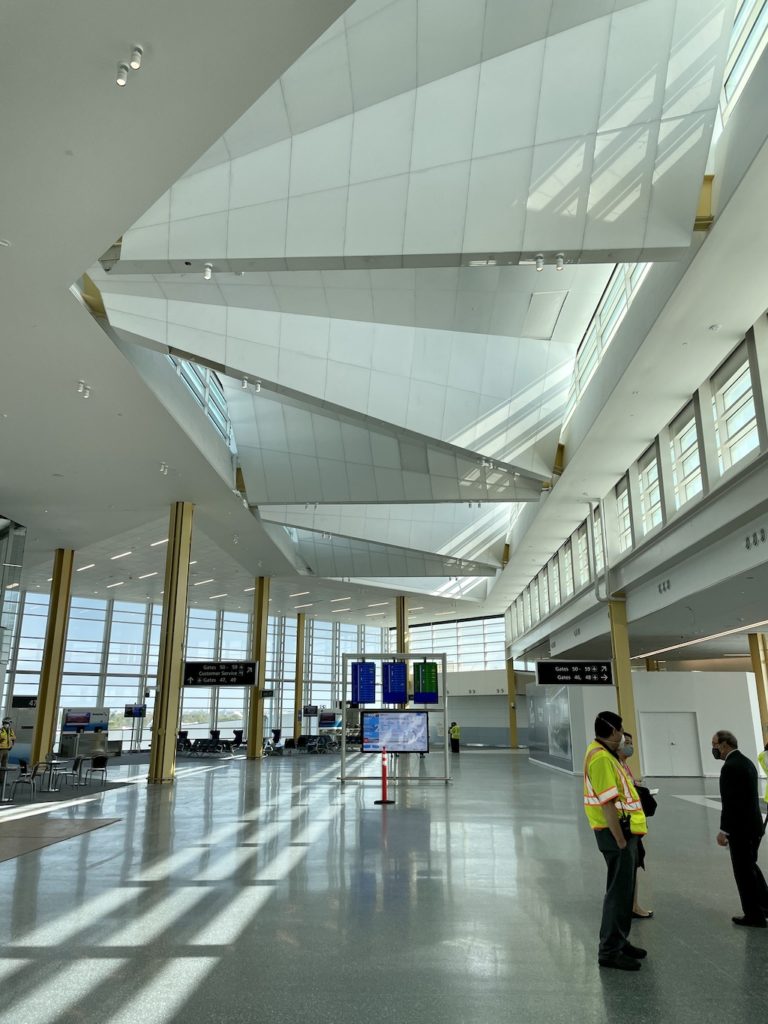Washington National Airport Delivers New $400 Million Concourse Early Due to Pandemic Lull

Photo Credit: American will begin flying out of a new concourse at Washington National airport next Tuesday, but the opening is the exception during the crisis. Airline Weekly / Edward Russell
Workers are putting the finishing touches on a new concourse at Ronald Reagan Washington National Airport, one of the few major airport projects that was able to use the coronavirus pandemic to open its doors early.
The 14-gate facility will begin handling flights for American Airlines on April 20, in what operator the Metropolitan Washington Airports Authority (MWAA) calls a "soft opening." In the works for the better part of a decade, the concourse will open roughly three-months early thanks to the drop in passengers — and flight levels — during the pandemic.
“What a great time to accelerate a new facility — [we can] work out all the kinks on an easier schedule," said American Vice President of Network Planning Brian Znotins referring to opening when flight numbers remain depressed.

But that time savings — and the opening itself — is the outlier, rather than the norm, in the crisis. Most airports have been forced to delay or indefinitely postpone major capital projects amid the drop in revenues that comes from fewer travelers, said Airports Council International-North America (ACI-NA) CEO Kevin Burke. For example, Pittsburgh delayed its terminal redevelopment a year, and Dallas/Fort Worth has indefinitely postponed plans for a new Terminal F.
"The issue for most airports is how do we get the cash to modernize," he said. Small- and medium-sized airports have been hit the hardest by the drop in revenues for improvement projects.
This is not to say a few airport projects have not moved forward in spite of Covid-19. In addition to Washington National, airports in Baltimore, Nashville, Portland, Ore., and Salt Lake City have all opened expansions on time or early during the crisis. But these are the exceptions and not the norm, said Burke.
Federal Covid relief funds made up some of that revenue shortfall. Airports have received $20 billion to date in the CARES Act and subsequent bills. And President Joseph Biden has recommended an additional $25 billion in his $2 trillion infrastructure proposal, the American Jobs Plan.
ACI-NA maintains that airports need $115 billion to modernize and prepare for future growth.
A 'New World' for American
The concourse is a big upgrade for American's operations and travelers. The space replaces the cramped Gate 35X — a ground-level waiting area where passengers catch buses to remotely parked aircraft — that was known as something of an equalizer, where D.C. power brokers from both sides of the aisle often found themselves mixing. Who could forget the time when Special Counsel Robert Mueller and Donald Trump Jr. were spotted mere feet apart waiting for flights while the former was investigating then President Donald Trump?

While bus gates are common at airports around the world, they are rare in the U.S. This prompted The Washington Post to recently call 35X "just a bus station, in an airport." Similar gates around the country have disappeared as airports replaced them with dedicated concourses for regional flights similar to the one opening at Washington National.
"This means the world, really," said Glen Zacek, director of DCA customer service at American-subsidiary Piedmont Airlines, during the tour Thursday. "This is a whole new world compared to 35X."
On the operations front, airline staff will no longer need to manage flights — and often frustrated passengers — in the cramped 35X space. And they will also no longer have to work outside in the elements at remote stands. This should boost morale and create potential operational efficiencies, said Zacek.
Another upside is a new automated system that guides aircraft to their parking position at the gate. While American still plans to have marshallers on the tarmac for each flight, the new system could improve operations, especially during bad weather.

The new concourse also allows American to move forward with its growth plans at Washington National. Prior to Covid-19, it listed the airport as one of its three most profitable hubs — along with Charlotte and Dallas/Fort Worth — and had ambitious plans to grow by flying larger jets on existing flights at the slot-controlled airport.

"We will be, this summer, up to about 180 flights [a day]," said Radney Roberston, managing director of DCA operations at American. "The long-term strategy remains the same."
Prior to the crisis in the summer of 2019, American had as many as 246 daily departures from Washington National, according to Cirium schedules. In the U.S., the airline plans to fly roughly 90 percent of its 2019 schedule this summer.
A 'Vision' of César Pelli's Washington Terminal
The new concourse extends from the northern end of Terminal B/C at Washington National. Travelers can look out from its windows across the Potomac River to the Washington Monument and U.S. Capitol dome in the adjacent city.
The space mimics Terminal B/C, which was designed by architect César Pelli and opened in 1997, in many ways. For example, it includes what Pelli called "Jeffersonian domes" atop the hammerhead at the end of the concourse.

"We're providing a vision that this is an extension of Terminal B/C," said Louis Lee, MWAA's in-house architect who worked with designer PGAL on the project. Some improvements over Pelli's design include wider spaces between columns to accommodate more passengers and moving concessions out of the concourse hammerhead to provide more space for people waiting for their flights.

Adding space for travelers is an important improvement for MWAA. Part of the reason for the project, which is part of a larger $1 billion airport expansion that also includes still under construction new security checkpoints, was accommodating higher than forecast passenger numbers. When Terminal B/C opened the airport anticipated roughly 15 million annual travelers, but by 2019 it saw nearly 24 million.
The full benefit of the new concourse is unlikely to be felt until air travel is back to its new normal after the pandemic. Washington National handled just 7.6 million travelers in 2020 — a steep 68 percent drop from the year before — and airport executives do not expect numbers to recover for some time. The International Air Transport Association (IATA) forecasts the recovery stretching into 2024, though domestic flyers — like those who National caters to — are expected to come back sooner.
“If the Smithsonian is not open, if conventions aren’t happening — people aren’t going to travel [to Washington]," MWAA CEO Jack Potter said at a board meeting in March. And that, fundamentally, will mean more to the airport's recovery than any new concourse.
